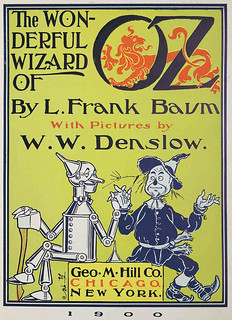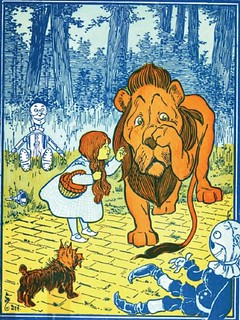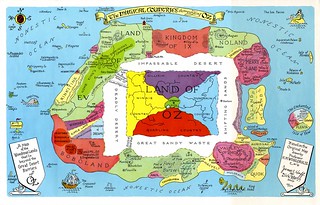 Tornadoes, flying monkeys, and ruby slippers. When you mention these three things together audiences everywhere immediately think of Dorothy Gale’s adventures in Oz. L. Frank Baum published The Wonderful Wizard of Oz in 1900, the novel was then followed by a series of books capturing the multiple adventures of Dorothy, Scarecrow, and the Witches of Oz. The stories have been popularized through modern derivative works like Gregory Maguire’s Wicked: The Life and Times of the Wicked Witch of the West which was famously adapted into the well know Broadway musical Wicked. Although the books have become popular in recent years they won iconic fame through MGM’s 1939 film adaptation The Wizard of Oz starring the now well known Judy Garland.
Tornadoes, flying monkeys, and ruby slippers. When you mention these three things together audiences everywhere immediately think of Dorothy Gale’s adventures in Oz. L. Frank Baum published The Wonderful Wizard of Oz in 1900, the novel was then followed by a series of books capturing the multiple adventures of Dorothy, Scarecrow, and the Witches of Oz. The stories have been popularized through modern derivative works like Gregory Maguire’s Wicked: The Life and Times of the Wicked Witch of the West which was famously adapted into the well know Broadway musical Wicked. Although the books have become popular in recent years they won iconic fame through MGM’s 1939 film adaptation The Wizard of Oz starring the now well known Judy Garland.
 Although the story is well known and loved by children of all ages the book has faced harsh criticism since its publication. The novels are commonly accused of portraying unwholesome and ungodly ideals. In 1928 all public libraries banned the book arguing that the story was ungodly for “depicting women in strong leadership roles”. This argument remained the common defense against the novels from ministers and educators through the 1950s and 60s. In 1952 a Florida librarian named Dorothy Dodd publicly denounced the books stating that they were unwholesome for young readers. Then in 1957 the Detroit Public Library banned Baum’s tales by stating the novels had “no value for children of today”, arguing the stories and characters supported “negativism and brought children’s minds to a cowardly level”. Luckily, Dr. Russel B. Nye of Michigan State University publically responded to this accusation by stating “if the message of the Oz books- that love, kindness, and unselfishness make the world a better place- has no value today, then maybe the time is ripe to reassess a good many of other things beside the Detroit Library’s approval list of children’s books”. (bannedbooks.world.edu).
Although the story is well known and loved by children of all ages the book has faced harsh criticism since its publication. The novels are commonly accused of portraying unwholesome and ungodly ideals. In 1928 all public libraries banned the book arguing that the story was ungodly for “depicting women in strong leadership roles”. This argument remained the common defense against the novels from ministers and educators through the 1950s and 60s. In 1952 a Florida librarian named Dorothy Dodd publicly denounced the books stating that they were unwholesome for young readers. Then in 1957 the Detroit Public Library banned Baum’s tales by stating the novels had “no value for children of today”, arguing the stories and characters supported “negativism and brought children’s minds to a cowardly level”. Luckily, Dr. Russel B. Nye of Michigan State University publically responded to this accusation by stating “if the message of the Oz books- that love, kindness, and unselfishness make the world a better place- has no value today, then maybe the time is ripe to reassess a good many of other things beside the Detroit Library’s approval list of children’s books”. (bannedbooks.world.edu).
 The most publicized banning case against The Wizard of Oz took place in 1986 when a group of seven Fundamentalist Christian families from Tennessee pushed for the novel’s removal from the public school syllabus. They filed a lawsuit against the schools arguing that “the novel’s depiction of benevolent witches and promoting the belief that essential human attributes were ‘individually developed rather than God given’”. They argued that all witches are bad, therefore it is “theologically impossible” for good witches to exist. So, in summary, they were opposed to the character Glinda the GOOD witch. One of the parents stated, “I do not want my children seduced into godless supernaturalism”, arguing that the books promoted self-reliance rather than dependency on God to provide salvation. The judge presiding over the case ruled that the children, whose families opposed the works, should be excused from lesson plans centered on the novel. The families then appealed the decision to the United States Supreme Court, SCOTUS refused to hear the case. (Chicago Tribune, Dec. 1986)
The most publicized banning case against The Wizard of Oz took place in 1986 when a group of seven Fundamentalist Christian families from Tennessee pushed for the novel’s removal from the public school syllabus. They filed a lawsuit against the schools arguing that “the novel’s depiction of benevolent witches and promoting the belief that essential human attributes were ‘individually developed rather than God given’”. They argued that all witches are bad, therefore it is “theologically impossible” for good witches to exist. So, in summary, they were opposed to the character Glinda the GOOD witch. One of the parents stated, “I do not want my children seduced into godless supernaturalism”, arguing that the books promoted self-reliance rather than dependency on God to provide salvation. The judge presiding over the case ruled that the children, whose families opposed the works, should be excused from lesson plans centered on the novel. The families then appealed the decision to the United States Supreme Court, SCOTUS refused to hear the case. (Chicago Tribune, Dec. 1986)
 Throughout the years the books have been opposed for their positive portrayals of femininity. Groups have opposed the ideal of savior female figures and the portrayal of powerful women on the same level as their male counterparts.
Throughout the years the books have been opposed for their positive portrayals of femininity. Groups have opposed the ideal of savior female figures and the portrayal of powerful women on the same level as their male counterparts.
To read more about the banning of The Wizard of Oz visit this website. And to see our exhibit detailing the censored history of Baum’s books visit Special Collections on the 5th floor of McFarlin library open to the public Monday-Friday 8-5.
